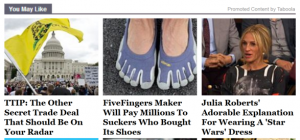This post is Part Two in a series on native advertising by Mad Fish. This post will focus on the ads types that are most commonly referred to as “native advertising:” Sponsored Content/Promoted Listings, Advertorials, and Recommendation Widgets.
For information on the history and definitions of native advertising, check out Part One in our series.
As we discussed in Part One, there is a wide spectrum of ad types within the arena of native advertising. The broad definition provided by the IAB doesn’t really provide a lot of insight into what exactly qualifies as native, but generally there are three types of ad units that are most often referred to as native ads: Sponsored Content/Promoted Listings, In Feed, and Recommendation Widgets.
Sponsored Content (In-Stream)
Buzzfeed has been by far the most successful publisher of sponsored content since its inception, providing an outline for advertisers to follow (“17 Reasons to Wash Your Hair in a Hailstorm!”), and visibility on a variety of topics.

Sponsored content units are some of the most effective native ad units. They are, however, also the most difficult to automate since they have to be so closely integrated to the format of the publisher content itself. This negatively impacts scalability and cost effectiveness of the campaign since advertisers have to buy directly from publishers, rather than through an exchange like AdWords or Bing. Recently, more traditional news publishers such as Forbes have jumped on the native bandwagon in varying degrees, including the New York Times and the Wall Street Journal.
Advertorials
Sponsored Content ad units generally show up on news sites within the feed itself, but can also turn up in their own section as advertorials, as is the case with Forbes Brand Voice.
In 2009, Forbes “BrandVoice” (recently changed from “AdVoice”) was launched as one of the first “native” advertorial solutions to appear on a major publication.
Native advertorials such as Forbes Brand Voice represent the opposite end of the in-feed native spectrum; while it is still formatted into the layout of the Forbes site, it is much more content driven. This content actually competes directly with non-branded content on the site’s “Most Popular” section, and stands in a stark contrast to an ad that is merely integrated into the same format as the rest of the platform.
Does it work? The numbers say it does – Forbes’ Brand Voice was estimated to represent 30% of the publication’s total ad revenue in 2014.
Recommendation Widgets
Recommendation widgets, often called out as ‘related content’ are usually found at the bottom of the page or in the sidebar. This content is still considered native, but it is more clearly separated and noticeable than In-Stream ads. This type of advertising is also the most scalable because it doesn’t need to be quite so carefully integrated into the content stream.
This is where native ad networks begin to make an appearance. Below are just two examples – Taboola, which distributes content for Huffington Post and The Weather Channel among others, and Outbrain, which disseminates content across such publishers as the Wall Street Journal and MarketWatch.
Each of these ad networks has varying degrees of functionality. The chart below offers a side-by-side comparison of three of the major native advertising platforms:
While the CPMs are fairly consistent across each platform, there is a wide range of minimum spends, from DIY for Outbrain to $25k for Nativo. But, as always, you pay for what you get. Nativo’s platform has much more detailed targeting capabilities, seemingly broader range of supported content, and a much wider publisher network.
Even with these options, true automation of native content remains a challenge for advertisers and publishers. In Part Three of this series, we will discuss the most effective ways to leverage these networks and how to promote your content the right way.






